Gold and Silver Shine on Weaker U.S. Dollar
Commodities / Gold and Silver 2012 Aug 21, 2012 - 07:26 AM GMTBy: Ron_Hera
 Gold, silver and crude oil prices are closely related to the movement of the U.S. dollar. After a healthy consolidation, gold began to move up in August 2012. At the same time, deteriorating expectations for crop yields in the American Midwest moved corn and soybean prices to new highs. Higher food prices in late 2012 or early 2013 could have far reaching and geopolitically destabilizing effects likely to weigh on stocks, putting the shine back on precious metals. While billionaires George Soros and John Paulson are buying gold, silver has been in backwardation in recent weeks and silver held in ETFs rose to $16.2 billion according to Bloomberg.
Gold, silver and crude oil prices are closely related to the movement of the U.S. dollar. After a healthy consolidation, gold began to move up in August 2012. At the same time, deteriorating expectations for crop yields in the American Midwest moved corn and soybean prices to new highs. Higher food prices in late 2012 or early 2013 could have far reaching and geopolitically destabilizing effects likely to weigh on stocks, putting the shine back on precious metals. While billionaires George Soros and John Paulson are buying gold, silver has been in backwardation in recent weeks and silver held in ETFs rose to $16.2 billion according to Bloomberg.
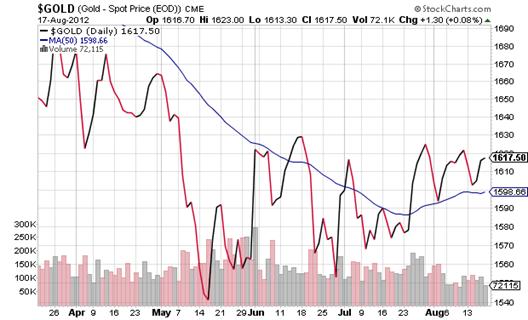
While increasing risk of geopolitical instability, including fear of a U.S. or Israeli war with Iran, account for rising crude oil prices and renewed interest in precious metals, the proverbial elephant in the room remains the U.S. dollar vis-à-vis a crumbling Euro. Precious metals mining stocks hit a low in mid May when the U.S. Dollar Index (USDX) shot up +5.5% (4.33 points) from 78.71 on April 27 to 83.04 on May 31. By July 24 the USDX had made a 2-year high of 84.10 as Spanish bond yields soared against a backdrop of continued worries over the European debt crisis. The U.S. dollar then slid -2.25% (1.89 points) to 82.21 on August 2, bouncing back to 82.60 by August 17 with a flat 50-day moving average as precious metals prices and mining stocks rose.
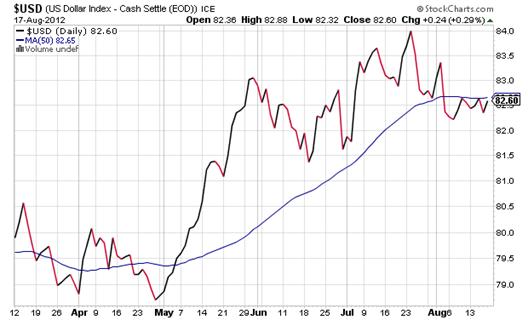
Gold mining stocks, in particular, have suffered due to higher costs related to higher energy prices and lower ore grades, which have compressed cash margins and pushed out returns on capital investments. Gold demand, however, has not abated and higher production costs effectively put a floor under the price of gold.
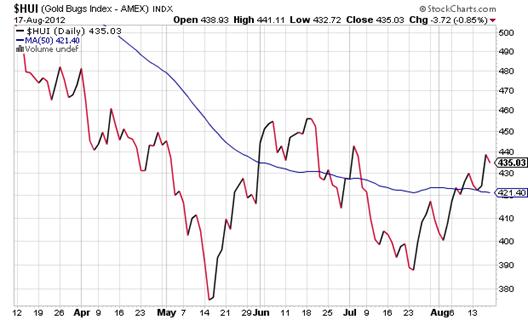
The key international measure of the U.S. dollar’s value is the price of crude oil. Recessions, depressions and economic slowdowns in the U.S., U.K., Europe, China and Japan have softened demand for crude oil, moderating crude oil prices and making the U.S. dollar stronger than it would have been otherwise.
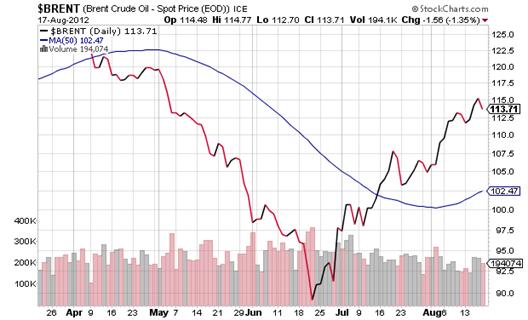
Weaker fuel consumption in the U.S. has been offset by steady global demand and fears of war in the Middle East which could disrupt oil shipments through the Strait of Hormuz in the Persian Gulf.
Although crude oil prices could moderate in the near term if tensions in the Middle East are resolved, it is more likely that the region will become more chaotic due to higher food prices in late 2012 or early 2013. Further, it is far more likely that conflict between the U.S. or Israel and Iran will escalate. In the long term, oil prices will rise due to growing global demand and higher production costs, i.e., for heavy sour crude, shale oil, etc.
Weak U.S. Dollar Fundamentals
The U.S. dollar is fundamentally weaker than it appears to be based on the USDX. Economic growth in the U.S. is extremely weak, despite massive government deficit spending. U.S. federal government debt of roughly $16 trillion, chronic budget deficits of more than $1 trillion per year and unfunded liabilities of more than $62.3 trillion are unsustainable compared to the U.S. Gross Domestic Product (GDP) of $15.29 trillion (2011 est.), which includes government deficit spending. On a Generally Accepted Accounting Principles (GAAP) basis, which accounts for unfunded liabilities, the U.S. federal deficit would be approximately $5 trillion. The U.S. debt to GDP ratio is approximately 100%, which is worse than that of Spain. Further, the U.S. remains embroiled in foreign wars and continues to prosecute a global “War on Terror” at a total combined cost of several trillion dollars to date.
The Federal Reserve has purchased a large portion of U.S. Treasury bonds since 2008, making the demand for U.S. debt appear stronger than it would have otherwise and artificially suppressing treasury bond yields. The Federal Reserve’s asset purchases (buying toxic mortgage backed securities, quantitative easing I and II and “operation twist”, etc.) represent “money printing”. Money printing weakens the currency and causes prices to rise, which punishes savers, workers and consumers in general. The U.S. Bureau of Labor Statistics’ Consumer Price Index (CPI) has shown little change but pre-1980 measures of inflation are as high as 9%.
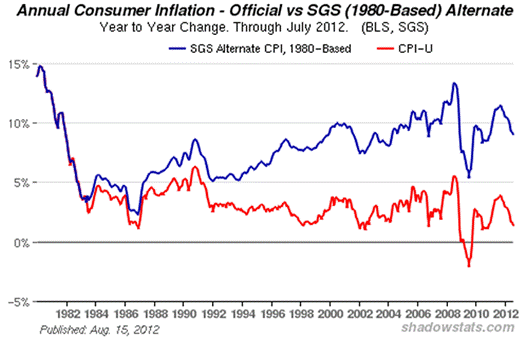
U.S. domestic price inflation is evident to consumers in terms of food and energy prices, if not in the CPI. The rising cost of living in the U.S. must be contrasted with declining real income and high unemployment. Unemployment in the U.S. indicates a long-term, structural decline in the U.S. job market. Specifically, the civilian population employment ratio has declined for more than a decade.
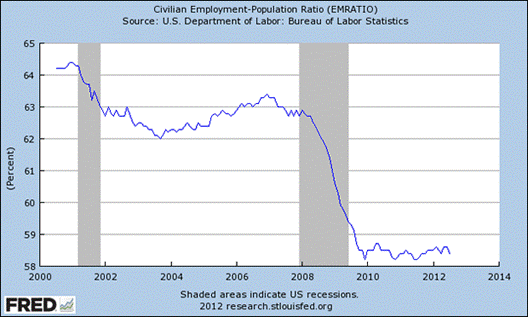
By all rights, the U.S. dollar should be far weaker, but, to quote Sir Winston Churchill, “the dollar is the worst currency, except for all the alternatives.” The USDX is a weighted geometric mean of the U.S. dollar’s value compared with the euro (57.6% weight), the Japanese yen (13.6% weight), the British Pound sterling (11.9% weight), the Canadian dollar (9.1% weight), the Swedish krona (4.2% weight) and the Swiss franc (3.6% weight).
- Euro (EUR) – The saga of European sovereign debt, the threat of default, austerity versus economic growth, rating cuts, last minute rescues and civil unrest continues unabated. The Euro is, in fact, extremely weak which makes the U.S. dollar appear unnaturally strong. The European Central Bank (ECB) has little choice but to create more Euros to bail out the system.
- Yen (JPY) – Japan’s recession after a tragic series of economic shocks, i.e., the 2011 tsunami and Fukushima nuclear disaster resulted in an inflow of yen back into Japan, increasing demand in the foreign exchange market. The strengthening yen necessitated massive interventions by central banks to weaken the currency in order to stabilize trade.
- Pound sterling (GBP) – The U.K. is mired in a deep recession and the Bank of England is engaged in a series of monetary injections that have weakened the pound. There is no visible light at the end of the tunnel.
- Canadian dollar (CAD) – Because Canada’s economy is intertwined with that of the U.S., the Canadian dollar has remained more or less at parity with the U.S. dollar, although it has historically been the weaker of the two.
- Krona (SEK) – Sweden’s economy depends on exports and her largest trading partners are in the European Monetary Union, e.g., Germany, Finland, France, Netherlands and Belgium. If the krona appreciates, Swedish exports will fall.
- Swiss franc (CHF) – The Swiss National Bank has pegged the Swiss franc to the Euro depriving investors of a traditional safe haven.
The Most Favored Nation
China is struggling to maintain its exports and GDP growth in the face of economic deceleration while battling inflation and the fallout of regional real estate bubbles. The Renminbi (RMB) is closely linked to the U.S. dollar and is managed downward by the People’s Bank of China (PBoC) in order to support Chinese exports.
Due to the relative weakness of other currencies (mainly the EUR, GBP and RMB), the U.S. dollar’s recent strength is illusory. While a weaker U.S. dollar would aid U.S. exports and reduce the U.S trade deficit, high inflation would also punish savers, workers and consumers in general. A solution to the European sovereign debt crisis, a larger and longer term refinancing plan by the ECB, or signs of economic recovery in the Eurozone, would send the U.S. dollar down sharply. Additionally, strong growth in the BRIC countries or an economic recovery in China would greatly increase upward pressure on global commodity prices. Conversely, a continued slowdown in China, which is more likely, will reduce demand for base metals which is bullish for silver because most silver is produced as a byproduct of base metals mining.
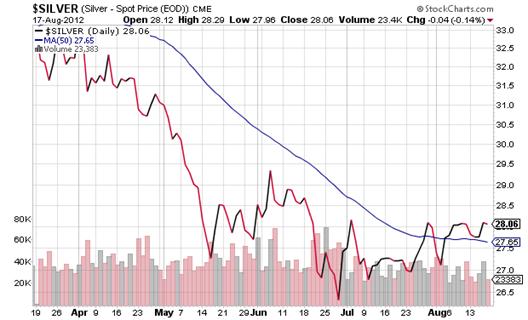
Platinum group metals (PGM) could fall as a function of weaker automobile demand if the Chinese economy continues to slow but Chinese automobile sales are up 22.6% year over year. Weaker automotive demand could be offset by safe haven investment demand for platinum and, in the short term, PGM prices are rising sharply due to ongoing mine labor problems in South Africa.
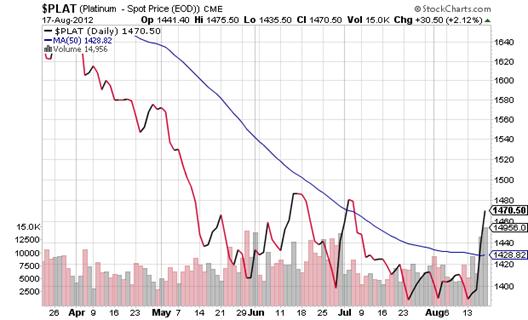
China, together with the other BRIC countries (Brazil, Russia, India and China), South Africa and Iran, is slowly but systematically preparing to move away from the U.S. dollar. At some point, the currently gradual movement of global trade away from the U.S. dollar will reach a critical mass and accelerate. The loss of its world reserve currency status is an existential threat to the U.S. dollar. For the time being, however, it is not in the interest of any of the major players, i.e., China, to dump the U.S. dollar. Despite poor economic conditions in the U.S., U.S. consumers are more addicted than ever to cheap imports from China.
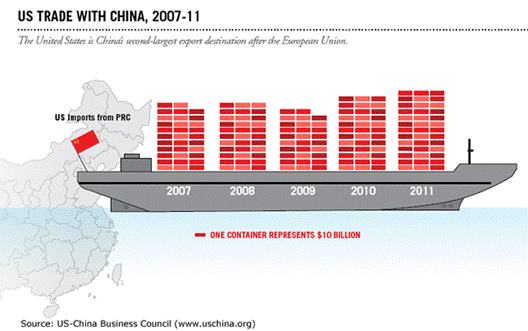
China is a major producer and importer of gold and Chinese companies are aggressively buying crude oil and natural resources around the world but, according to the PBoC, Chinese currency reserves grew 1.9% to $3.24 trillion as of June.
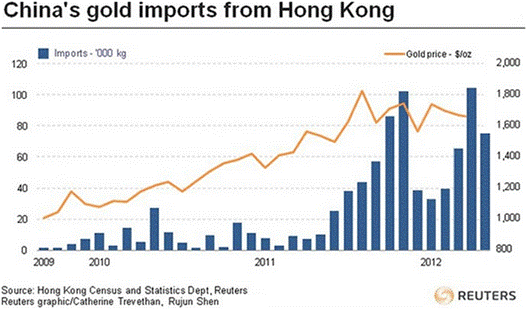
The PBoC and other central banks purchased 400 tonnes of gold in the 12 months ended March 31, 2012 compared with 156 tonnes during the same period in 2011, according to the World Gold Council.
Gold, Silver, Crude Oil
Given the weak fundamentals of the U.S. dollar and the fact that its weakness has been masked by a variety of factors, prices could increase too quickly for policy makers, i.e., Federal Reserve Chairman Ben Bernanke, to respond. The U.S. dollar is vulnerable in the face of potential Eurozone stabilization, stronger than expected demand from BRIC countries, or geopolitical disintegration linked to higher food prices. Additionally, further intervention by the Federal Reserve could send the U.S. dollar sharply downward and cause a disruptive spike in global commodity prices. Pressure on the Federal Reserve to engage in further monetary easing, e.g., quantitative easing III (QE3), or an equivalent program, is growing. Gold, silver and related mining shares will rally heading into late 2012 and are likely to break out dramatically as current trends develop.
About Hera Research Hera Research, LLC, provides deeply researched analysis to help investors profit from changing economic and market conditions. Hera Research focuses on relationships between macroeconomics, government, banking, and financial markets in order to identify and analyze investment opportunities with extraordinary upside potential. Hera Research is currently researching mining and metals including precious metals, oil and energy including green energy, agriculture, and other natural resources. The Hera Research Newsletter covers key economic data, trends and analysis including reviews of companies with extraordinary value and upside potential.
###
Articles by Ron Hera, the Hera Research web site and the Hera Research Newsletter ("Hera Research publications") are published by Hera Research, LLC. Information contained in Hera Research publications is obtained from sources believed to be reliable, but its accuracy cannot be guaranteed. The information contained in Hera Research publications is not intended to constitute individual investment advice and is not designed to meet individual financial situations. The opinions expressed in Hera Research publications are those of the publisher and are subject to change without notice. The information in such publications may become outdated and Hera Research, LLC has no obligation to update any such information.
Ron Hera, Hera Research, LLC, and other entities in which Ron Hera has an interest, along with employees, officers, family, and associates may from time to time have positions in the securities or commodities covered in these publications or web site. The policies of Hera Research, LLC attempt to avoid potential conflicts of interest and to resolve conflicts of interest should any arise in a timely fashion.
Unless otherwise specified, Hera Research publications including the Hera Research web site and its content and images, as well as all copyright, trademark and other rights therein, are owned by Hera Research, LLC. No portion of Hera Research publications or web site may be extracted or reproduced without permission of Hera Research, LLC. Nothing contained herein shall be construed as conferring any license or right under any copyright, trademark or other right of Hera Research, LLC. Unauthorized use, reproduction or rebroadcast of any content of Hera Research publications or web site, including communicating investment recommendations in such publication or web site to non-subscribers in any manner, is prohibited and shall be considered an infringement and/or misappropriation of the proprietary rights of Hera Research, LLC.
Hera Research, LLC reserves the right to cancel any subscription at any time, and if it does so it will promptly refund to the subscriber the amount of the subscription payment previously received relating to the remaining subscription period. Cancellation of a subscription may result from any unauthorized use or reproduction or rebroadcast of Hera Research publications or website, any infringement or misappropriation of Hera Research, LLC's proprietary rights, or any other reason determined in the sole discretion of Hera Research, LLC. ©2011 Hera Research, LLC.
© 2005-2022 http://www.MarketOracle.co.uk - The Market Oracle is a FREE Daily Financial Markets Analysis & Forecasting online publication.



